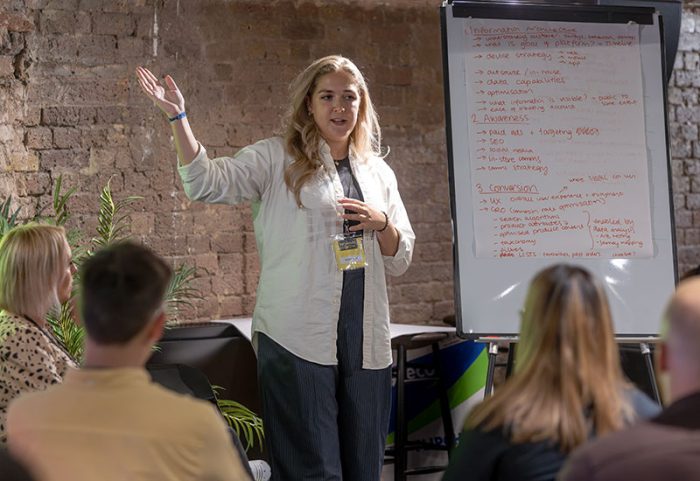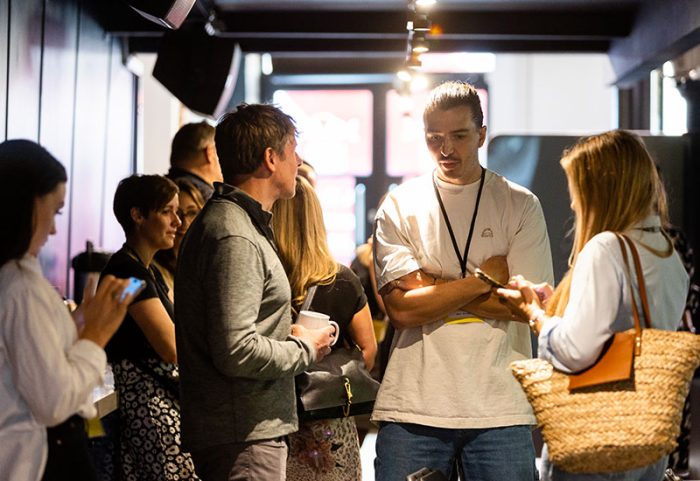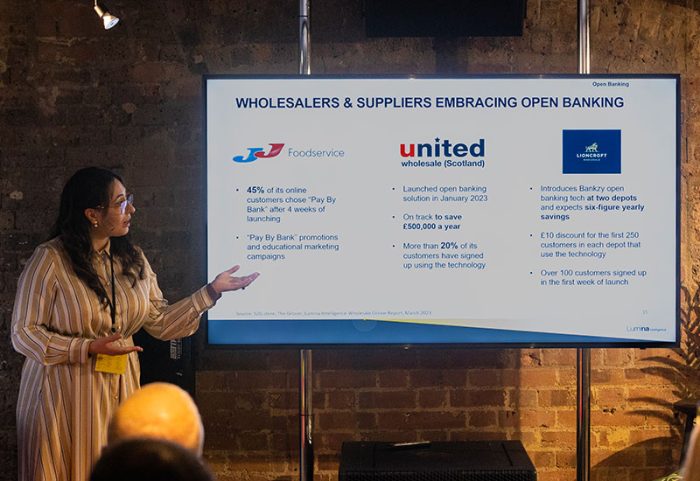eWholesale Collective: Let’s get digital
Wholesale News gathered e-commerce experts from across the industry for this year’s eWholesale Collective masterclass on harnessing digital opportunities. So what did we find out?
Photography: Roy Kilcullen
Watch highlights of this year’s event in the video below:
ATTENDEES
- For PepsiCo: Amber Madkour, Thomas Chaplin, Johnathan Orchiston
- For Carlsberg Marston: Ellie Price, Ellie Cheeseman, Harriet Johnson
- For Red Bull: Lotte Tregear, Octavia Prendergast, Sydney Bron, Ben Hirst
- For Mars Wrigley: Matt Petit, Alex Cuthbert
- Maria Georgio, Lumina
- Holly Franklin, Lumina
- Tanya Pepin, TWC
- Chris Evans, b2bstore
- Hannah Wookey, Circana
- Lorraine Hartley, Circana
WHOLESALERS
- Claire Chin, Bestway
- Lucy Boland, Caterforce
- Kieran Hartley, Caterforce
- Toby Jordan, Fairway Foodservice
- Shruti Senapati, Sugro UK
- Humeera Manzoor, Sugro UK
- Kristan Dodge, Hunt’s Food Group
- Ross Gourlay, Glencrest
- Inga Gourlay, Glencrest
- Ravi Kotecha, HT Drinks
- Patrycja Newton, LWC
- Samir Samaani, Wow Box Me
- Stran Budak-Uludag, RA Trading
- Deepti Tailor, Sandea Wholesale
For many wholesalers trading in 2023, a strong online presence is as essential as unlocking the doors to the cash and carry.
An engaging ecommerce platform isn’t just about offering a 24/7 experience for your customers, but so much more. With personalised offers, targeted promotions and tailored communications, the benefits of embracing digital are far reaching and lucrative.
The eWholesale Collective – comprising Wholesale News and four leading brands, Carlsberg Marstons, Mars Wrigley, PepsiCo and RedBull – brought together a range of industry experts, buying groups, and to take part in a digital masterclass. The event, held at Red Bull’s Seven Dials head office, examined the trends, opportunities and challenges for wholesalers exploring the digital space and looking to future-proof their business.
Delegates were put into groups, each with a challenge to discuss either mastering the basics, data strategy or device strategy and feed back to the group. The discussions are summarised below.

GROUP 1: MASTERING THE BASICS
INFORMATIONAL ARCHITECTURE
It’s important for wholesalers to understand their customers’ goals when it comes to creating an ecommerce platform. Who is your customer, and what is their shopping behaviour? What do they want from their wholesaler and how do they want to interact with an ecommerce site? How does this match with how they interact with you offline? This information can be found through a range of tools, such as surveys, and then you can then use this information to identify customer goals. Do they want to be fully online? Do they have a participation goal that they want to reach with their customers and a plan for how to get there? DEVICES Once they understand what they want to do with their platform, it’s important to think about what device the platform will suit.
There are significant opportunities with mobile phones that remain unutilised. App metrics are higher than websites, with higher frequency, increased session times and greater order value, which is something that small wholesalers could tap into.
TO OUTSOURCE OR NOT TO OUTSOURCE
Wholesalers should consider the benefits of outsourcing e-commerce opportunities versus doing it in-house. Acknowledge the resources you have available and whether you have the data and the capabilities to do it in-house, or work with partners who have the expertise.
DATA
It is critical that you identify the data you already have about your customers when it comes to the customer journey and how you’re going to use it when optimising your e-commerce offering.
COMMUNICATION IS KEY
How do you raise awareness of your new ecommerce platform? There are great tools at our disposal such as SEO, social media, in-depot communication and emails.
Consider your end goal throughout the process to optimise your communications.
SALES CONVERSIONS
The overall user experience is crucial to increase conversion rates. Create an enjoyable, interactive user experience for customers that matches their in-depot experience by making products on the website as discoverable as possible.
Customers know where to find products in depot so match this online with optimised brand and category search terms. Lists are really effective at reminding customers of products they have bought or favourited in the past and contribute to conversions.
RETENTION AND LOYALTY
For wholesalers with an established e-commerce offering that are looking to increase retention and loyalty, there are many ways you can add value to keep customers coming back. Think reward schemes, loyalty cards, offers and tiering of promotions. All of these have the added benefit of creating data that you can use to tailor recommendations to customers.
GOING THE EXTRA MILE
Going above and beyond to provide additional services such as banking and payment services will demonstrate how you are putting your customers first.

GROUP 2: DATA STRATEGY
ESTABLISH YOUR MILESTONES
When you’re establishing a data strategy, it’s essential to understand your starting point and your desired end destination. Establish core KPIs to keep track along the way. This will help you to keep it simple as well as reducing the cost and the risk.
LESS IS MORE
Some think that the more data you have, the better. However, as some data isn’t usable, this is often not the case. Data you can use is critical for success.
THINK BIGGER PICTURE
Mature wholesalers need to be thinking about the business as a whole. There is a challenge around data sharing, however from an online perspective sharing data is beneficial to all parties. Include data sharing as part of your conversations with suppliers around investment and you can apportion investment to the right part of the business.
AUTOMATION
Automation is key. To really harness the benefits, it’s important to have one centralised place to store data.
OPTIMISATION
How can wholesalers monetise data to drive incremental revenue? Optimisation evolution becomes a centralised part of the customer journey, tracking customers through the platforms.
CATEGORY PARTNERSHIPS
Wholesalers need to work with supplier partners to leverage customer knowledge and expertise in order to become a true category partner to drive incremental growth.

GROUP 3: DEVICE STRATEGY
CONSIDER MULTIPLE DEVICES
Spoiler alert: there is no simple strategy for wholesalers when it comes to device strategy; it’s important to consider using multiple devices and optimising all of them.
Different devices play different roles in the customer experience and there are tools that wholesalers can use to benefit their device strategy, such as scanning devices and communication apps such as WhatsApp, to support those wholesalers embracing a mobile-first strategy.
Content must be optimised for all devices. Research shows that the mobile shopper has an increasingly shorter attention span, which may change marketing content, and it’s likely that Gen Z will have a shorter attention span and are likely to use mobile too.
DESKTOP VS MOBILE
Wholesalers regard the desktop as their lead device, used throughout business management. For foodservice, this is the same, while convenience retail customers are leaning more towards mobiles which may be driven by the use of scan functionality, and gap scanning.
OFFER CHOICE
Wholesalers must deliver options for customers. While a mobile-optimised website is key because all wholesalers will have shoppers who are mobile-first, there is still the need to reflect desktop-first customers. Wholesalers that offer both will reap the rewards.
Categories eWholesale Collective















